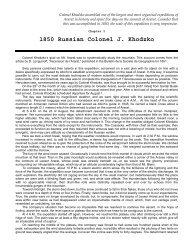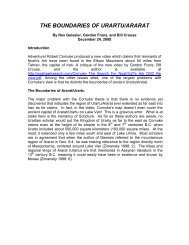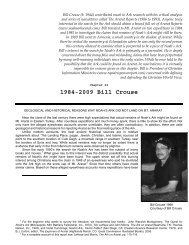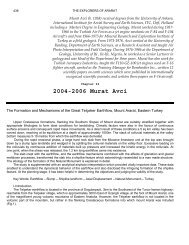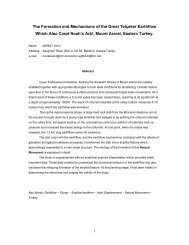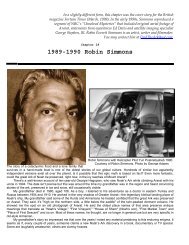1876 British Viscount & Ambassador James Bryce - Noah's Ark Search
1876 British Viscount & Ambassador James Bryce - Noah's Ark Search
1876 British Viscount & Ambassador James Bryce - Noah's Ark Search
Create successful ePaper yourself
Turn your PDF publications into a flip-book with our unique Google optimized e-Paper software.
176 THE EXPLORERS OF ARARAT<br />
In the repeated invasions and devastations of their country which occupied these weary years, a great part of the<br />
Armenian people were driven from it, and scattered over the adjoining lands, especially through Asia Minor, where<br />
their descendants still constitute a large element, probably nearly one-fourth, of the entire population; while the void<br />
which they left was partially, but only partially, filled up by the immigration of half nomad Mohammedan Tatars or<br />
Turkmans, whose villages now lie scattered through Russian and Turkish Armenia. The existence of Armenia as an<br />
independent state was at an end; and her later history, which I have neither the knowledge nor the time to describe, is<br />
little more than a dreary record first of warfare between the Byzantine emperors and the Seljukian Turks, then of<br />
devastations by the Mongols and the hosts of Timur, still later of a long and indecisive contest between the Ottoman<br />
sultans and Persia for the possession of these once flourishing provinces. But the Armenian people survived. In 1827<br />
the Czar Nicholas went to war with Persia, and wrested from here the whole upper valley of the Araxes, including<br />
Etchmiadzin itself. War with Turkey followed in 1828: the invaders under Paskievitch penetrated as far as Erzerum,<br />
and when they retired on the conclusion of peace in 1829, a multitude of Armenian subjects of Turkey followed them<br />
across the border and settled in Russian territory, where, unsatisfactory as we may think their condition, they are<br />
infinitely better off than they were under the Sultan or the Shah. I do not say that the Armenians love Russia, but<br />
neither do they hate her. The reviving sentiment of nationality, the generally diffused belief that the Ottoman power is<br />
sickening towards death, the spread of education, the easier intercourse with the West, the prosperity of individual<br />
Armenians in the foreign countries where they have established themselves as merchants, have all of them stimulated<br />
the hopes and aspirations of the more instructed classes, so that one even begins to hear of schemes for the erection<br />
of an Armenian state.<br />
At present Armenia is a mere geographical expression, a name which has come down to us from the ancient<br />
world, and has been used at different times with different territorial extensions. The country, if one can call it a country,<br />
has no political limits, for it lies mainly in the dominions of Turkey, but partly also in those of Russia and Persia. It has<br />
no ethnographical limits, for it is inhabited by Tatars, Persians, Kurds, and the mixed race whom we call Turks or<br />
Ottomans, as well as by the Armenians proper. It has no natural boundaries in rivers or mountain chains, lying, as it<br />
does, in the upper valley of the Euphrates, Tigris, Aras, and Kur. Wherever they go, they retain their faith, their peculiar<br />
physiognomy, their wonderful aptitude for trade.<br />
In Constantinople and most parts of Asia Minor, as well as in Transcaucasia, commerce is to a great extent in<br />
their hands; and they are usually found more than a match for either Jews or Greeks. Here, in their own country,<br />
however, they are chiefly peaceable, stay-at-home peasants, living in low, mud-built cottages, or sometimes in<br />
underground dwellings, tilling the soil just as their ancestors may have done thirty centuries ago, very ignorant, poor,<br />
and unambitious, scarcely distinguishable in dress and in some of their habits, except, of course, so far as religion<br />
comes in, from the Tatars who are interspersed among but never intermingled with them. Here, in Russian territory,<br />
the women go about unveiled, just as in Europe. According to Baron Haxthausen, an able German who traveled here<br />
thirty years ago, the young wife is for a year permitted to speak to no one save her husband, and to him only when<br />
they are alone; she may then talk to her baby, and after an interval to her mother-in-law, then to her sister-in-law, next<br />
to her sister, last of all to other women, but always in a whisper. Domestic slavery of course there was, as everywhere<br />
under Persian and Turkish rule; but all Armenians not slaves were equal: there was neither serf on the one hand nor<br />
any noble caste on the other. While every second Georgian you meet calls himself a prince, no Armenian seems now<br />
to claim any title of rank.<br />
Physically the Armenians are middle-sized, with a swarthy, yellowish complexion, less yellow, however, than that<br />
of the Persians, who are said to be (linguistically) their nearest relatives, black, straight hair, a forehead rather wide<br />
than high, and a large nose. The women are often handsome, with an erect carriage, regular features, and fine dark<br />
eyes. The language they now speak differs widely from that in which their ancient literature, dating from the fourth<br />
century, is preserved, and in which their worship is still conducted. They call it, and themselves, Haik, claiming to be<br />
descended from an eponymous hero Haik, who was the brother of Karthlos, ancestor of the Georgians, and the son of<br />
Thorgamos or Thogarmah, who was the son of Gomer the son of Japheth. It belongs to the Iranian group of the Indo-<br />
European family, and is said to be copious and strong, though certainly not melodious. The earliest inscriptions found<br />
in the country are in a cuneiform character; somewhat later, in Graeco-Roman times, the Greek alphabet was used by<br />
the Western, the Syriac by the Eastern Armenians, until, in the beginning of the fifth century, St. Mesrop invented the<br />
present Armenian character, and thereby, it has been thought, gave a considerable impetus to the independent<br />
national feeling of the people. The Turkish and Mongol invasions had destroyed what little learning or wealth had been<br />
left in the country.<br />
Some have risen to posts of high dignity. For instance, the commander of the invading Russian army in Asia at<br />
this moment, General Loris Melikoff, is an Armenian, as is the present governor of Daghestan. Their family, properly<br />
Melikian (ian is a patronymic in Armenian, like Mac or Ap), is one of the oldest and most respectable in Armenia. There<br />
are, I believe, thirty other Armenian generals in the service of the Czar.<br />
Nothing can be more pitiable than the condition of these poor people. They are not only (like the Rayahs of<br />
Bosnia and Bulgaria) plundered and outraged by rapacious tax gatherers and zaptiehs, they are also constantly<br />
exposed to the robberies of the marauding Kurds, who live among them, roving over the mountains in summer, and in<br />
winter descending to quarter themselves upon the Christian villagers, where they slay and pillage to their heart’s<br />
content. In fact, the sheep-dogs are little better than the wolves; the burning and plunder of the bazaar at Van, last



